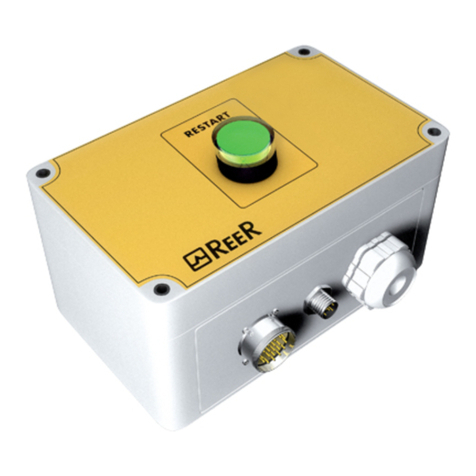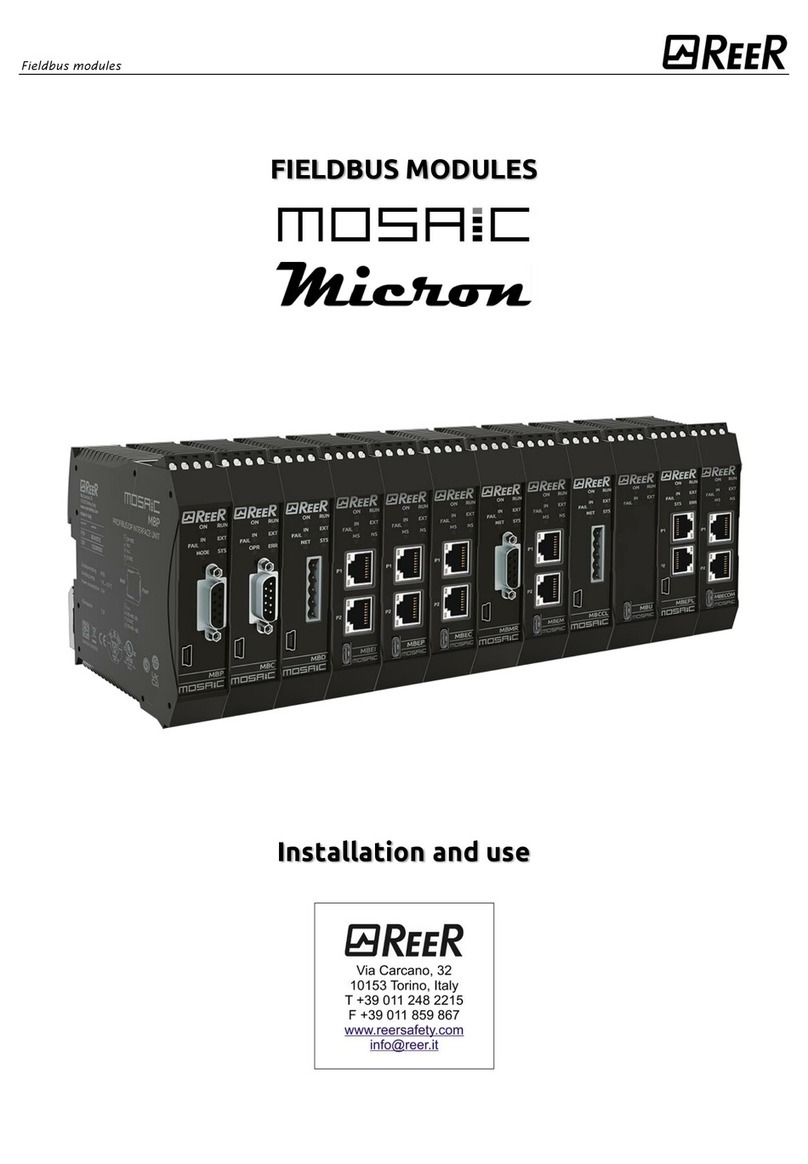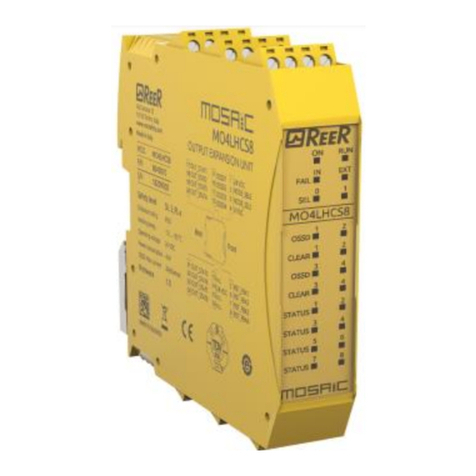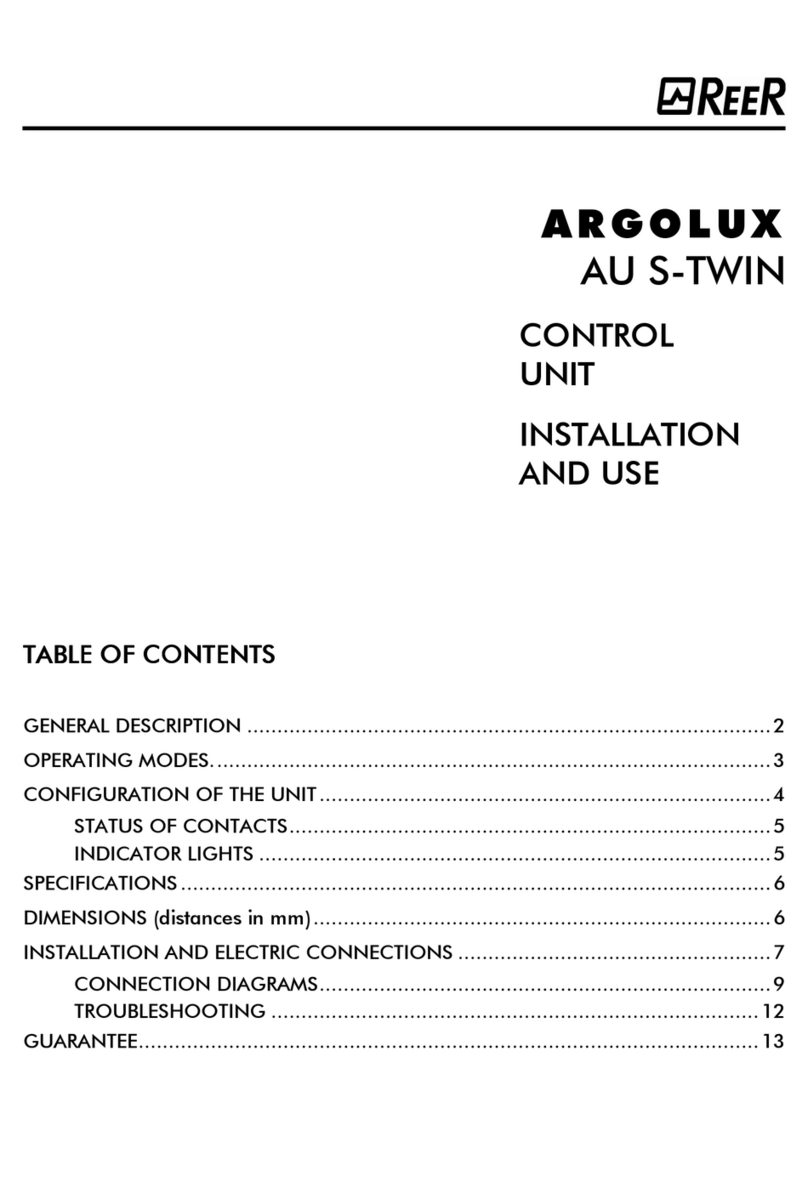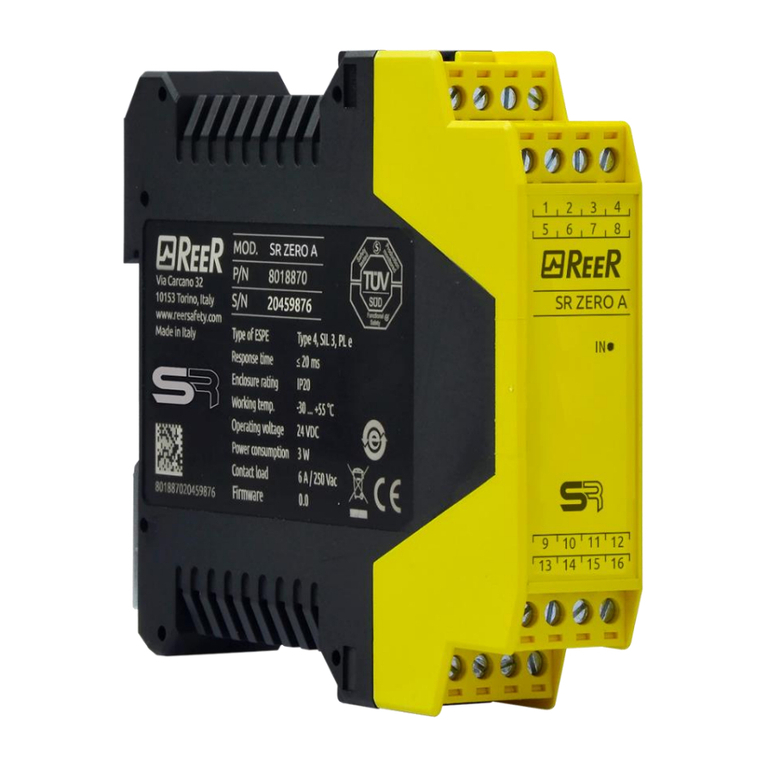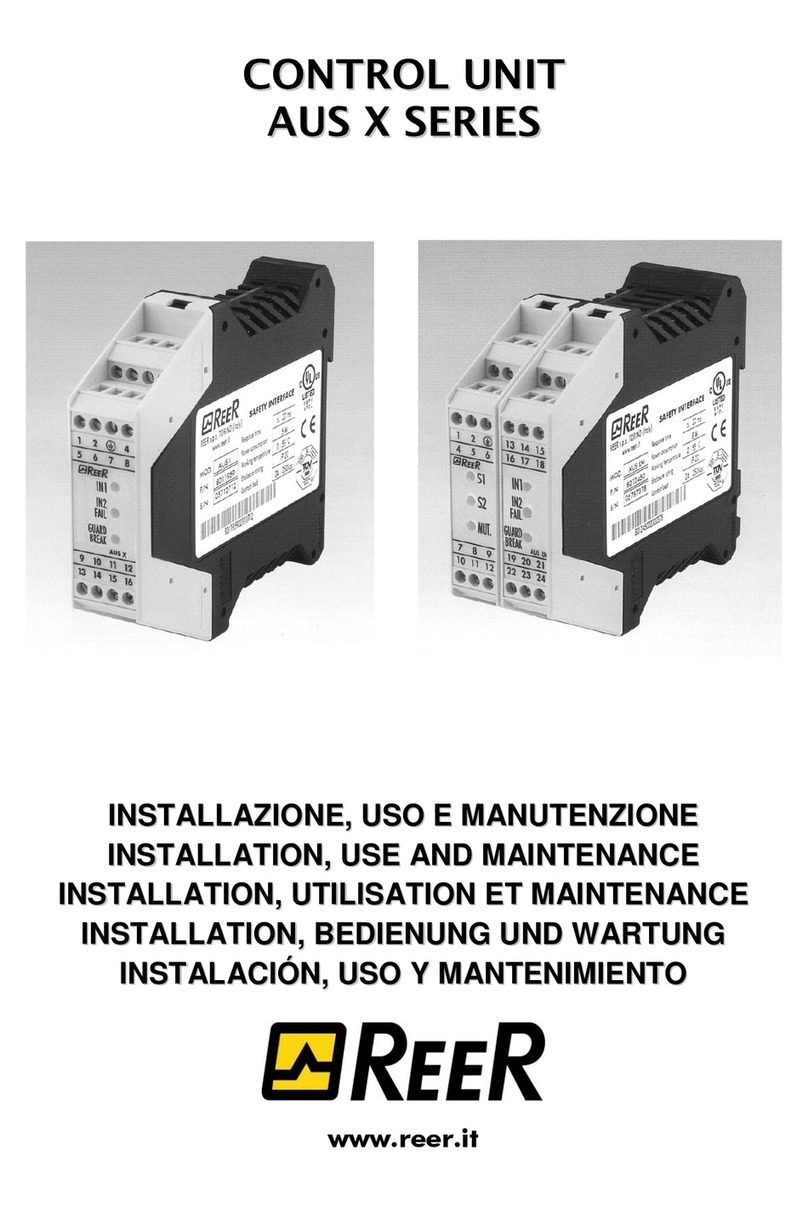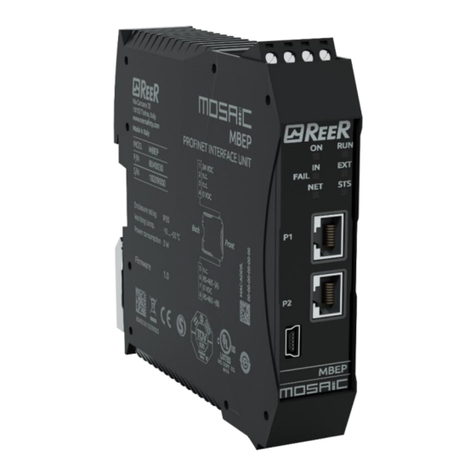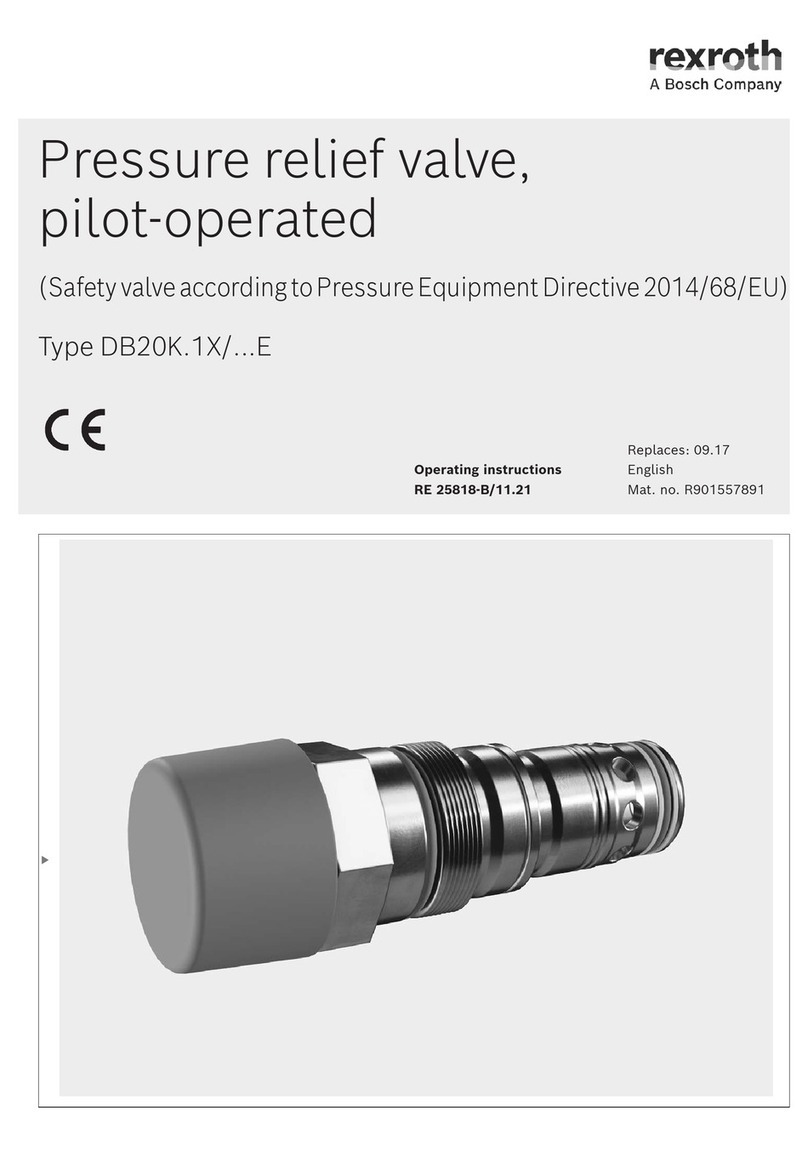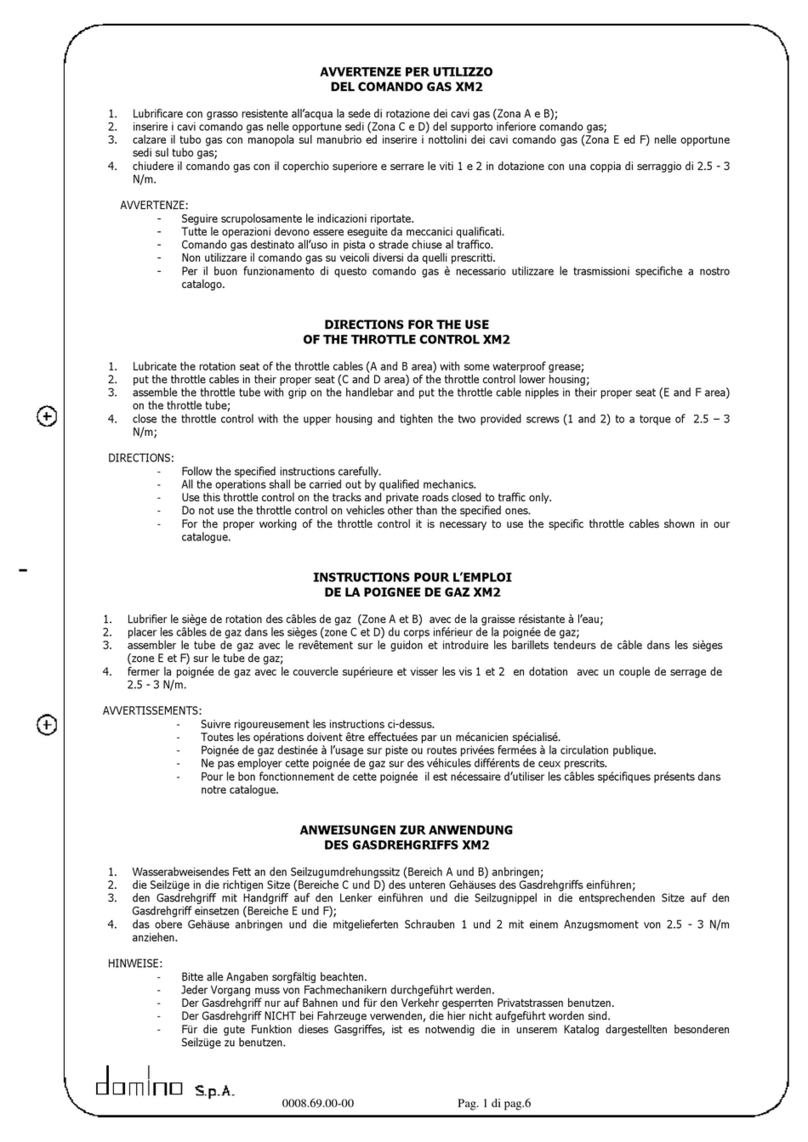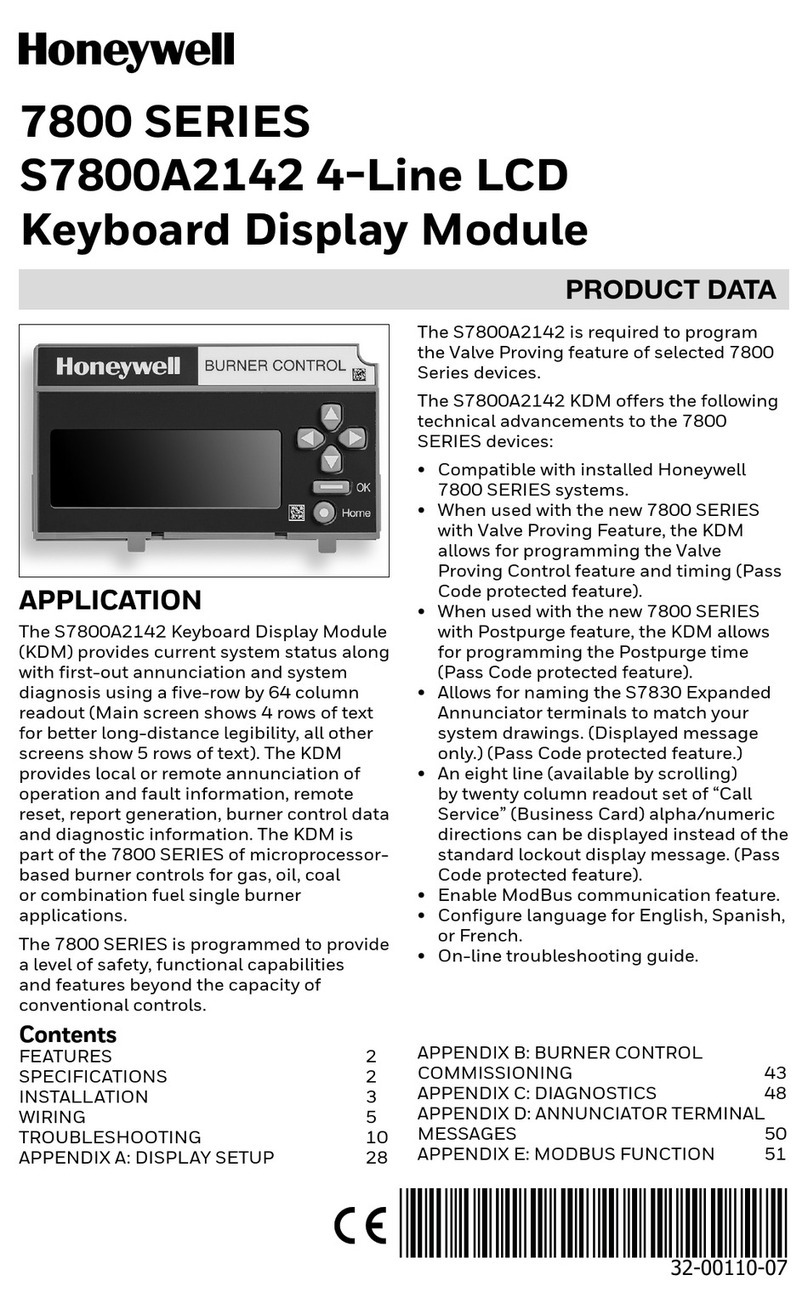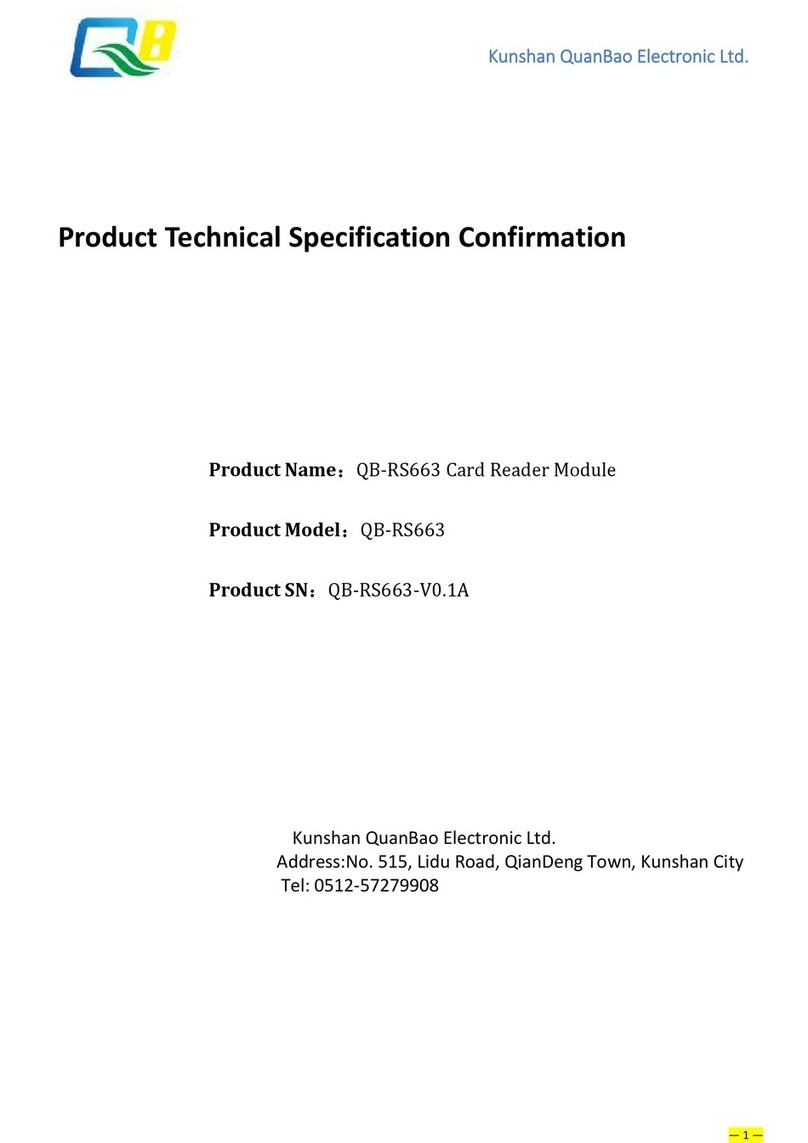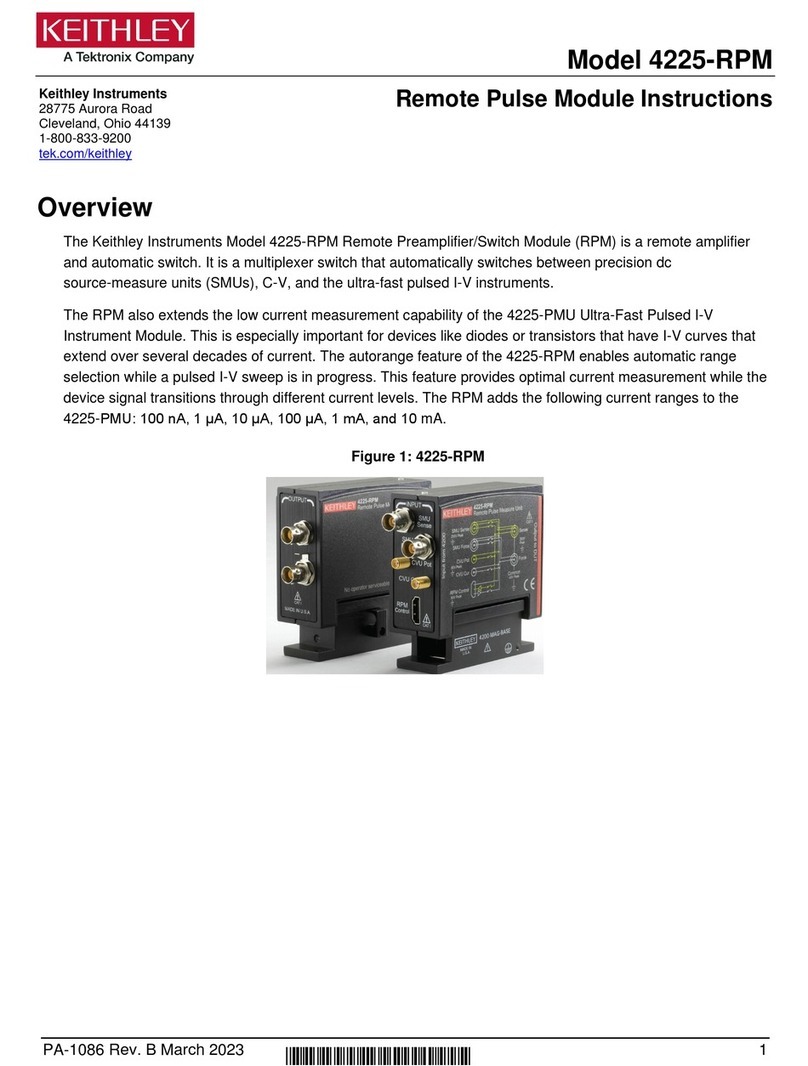Reer ARGOLUX AU S3M2 Quick start guide

ARGOLUX AU S3M2
CONTROL UNIT
WITH INTEGRATED MUTING FUNCTION
INSTALLATION, USE AND MAINTENANCEINSTALLATION, USE AND MAINTENANCE
INDEXINDEX
OVERVIEW ...........................................................................................................4
APPLICATIONS.............................................................................................4
CONTROL UNIT THEORY OF OPERATION AND STATES.................................5
AU S3M2 FUNCTIONING DIAGRAMS.........................................................11
CONTACT STATUS .....................................................................................13
LED STATUS INDICATIONS.........................................................................14
TECHNICAL DATA .............................................................................................. 15
DIMENSIONS .....................................................................................................16
INSTALLATION ...................................................................................................16
POSITIONING............................................................................................ 17
ELECTRICAL CONNECTIONS......................................................................22
CHECKS AND MAINTENANCE.................................................................... 29
MALFUNCTIONS........................................................................................ 29
IDENTIFICATION LABEL ......................................................................................31
WARRANTY ........................................................................................................31

2

3
The informations and the remarks given in this instruction manualThe informations and the remarks given in this instruction manual
may be subject to change due to further development of themay be subject to change due to further development of the
Argolux AS System.Argolux AS System.
Since the knowledge of this manual is fundamental for theSince the knowledge of this manual is fundamental for the
appropriate fitting and use, always refer the one included in theappropriate fitting and use, always refer the one included in the
shipping box of the product.shipping box of the product.

4
OVERVIEW
The AU S3M2 control unit is a complete system for control of type 2
electro-sensitive safety equipment (ESPE) in compliance with the European
standard prEN 50100 project for accident prevention on hazardous
machines and plants.
When correctly connected to a safety barrier or to a safety device that
performs the sensing function, the AU S3M2 control unit checks safe
functioning of the sensing device by sending a test signal and assessing its
reply time.
With its integrated intrinsic safety circuit, the AU S3M2 control unit is able
to detect any hardware faults in its internal circuits and also checks correct
functioning of its own output circuit consisting of two guided contact safety
relays.
Correct functioning of external auxiliary relays or contact blocks is also
checked at each test cycle, with also permanent automatic monitoring of
the muting and override function circuits.
If a system malfunction is detected, the AU S3M2 unit promptly de-
energizes its output circuit and switches to fail condition.
Control unit status is output continuously by leds while the self-test output
permits remote management of information regarding correct functioning
of the device.
APPLICATIONSAPPLICATIONS
The AU S3M2 control unit (combined with Argolux AS series light barriers)
can be used effectively in all sectors of industrial automation requiring
control and protection of access points to danger areas.
The device, with its own internal circuit able to assure safe management
of the muting function, is particularly suited for protection of access points
to the load and unload areas of:
•automatic palletizing/depalletizing systems;
•materials handling and storage systems;
•packaging and wrapping machines;
•assembly lines;
•industrial automatic warehouses.
When combined with an Argolux AS light barrier and connected to
specific muting sensors that complete the system for this type of
application, the AU S3M2 control unit provides an efficient solution to the
problem of man/material discrimination at dangerous access points
characterized by transit of pallets.

5
CONTROL UNIT THEORY OF OPERATION AND STATESCONTROL UNIT THEORY OF OPERATION AND STATES
Test function.Test function.
A type 2 safety system maintains its protective function by checking correct
response to an external test command. The system must stop if the test
detects a fault that could impair safety.
At power-on or each time the light barrier is interrupted, if the area
controlled is free, the AU S3M2 unit switches to clear status with output
relays A and B de-energized. The test contact must be closed in order to
enable the next work cycle.
FThe test command must precede the start command of theThe test command must precede the start command of the
machine that initiates the next work cycle.machine that initiates the next work cycle.
FThe output relays of the AU S3M2 control unit are energizedThe output relays of the AU S3M2 control unit are energized
only if the test is positive.only if the test is positive.
The test function is always enabled at any point of the machine cycle
provided the light barrier is free. This means that correct system
functioning can be checked at any time without necessarily occupying the
protected area.
The first part of the test checks correct functioning of the light barrier.
Occupation of the sensitive area is simulated in this phase, checking the
response time and correct functioning of the output circuit.
Subsequently, the AU S3M2 checks the response time of its own output
circuit consisting of two guided contact safety relays.two guided contact safety relays.
The output chain is kept open during the entire test phase and this
condition is maintained also during checks on the response times of
internal relays A and B which are energized and checked in two separate
phases.
If the test is positive, the control unit causes energization of its output
relays A and B and, using a feedback circuit, checks the switching times of
any external auxiliary relays or contact blocks (K1 and K2). If this test is
also positive, the control unit switches to guard statusguard status and enables the
next operating machine start command.
If no fault is detected, guard status is maintained until the area controlled
by the light barrier is intercepted.
Occupation of the area controlled causes immediate drop-out of output
relays A and B and the control unit switches to break status.break status. The test
command is not operative in this condition and the area controlled must
be freed in order to carry out a new test cycle.
If a test fails, the control unit switches to fail statusfail status preventing energizing
of the output relays.
This error condition, characterized by blocking of the unit with the output
relays de-energized, is also sent towards the outside through switching of
the self-diagnosis output on the unit.

6
Muting function.Muting function.
The muting function (temporary bypassing of the light barrier) is
indispensable when transit of material to the danger area through the
access protected by the light barrier must not cause stoppage of the
machine and consequent restart preceded by the test command.
According to safety regulations, the muting function can be activated only
if two signals are present, at least one of which must be of the hardware
type, i.e. coming from a field sensor.
An additional sensing system (muting sensors)(muting sensors) is therefore required which,
if configured correctly, provides the control unit with information (muting(muting
signals)signals) regarding transit of the material "authorized" to access the
danger area.
The control unit activates and de-activates the muting function only with
the correct muting sequence, characterized by a specific signal timing, at
its inputs.
During the period in which the function is active, the AU S3M2 control
unit is in muting status and, although it detects occupation of the light
barrier, does not generate the signal which, in any other condition, would
cause stopping of the machine. The presence of material at the access
point controlled must prevent operator access to the danger area.
As contemplated by safety regulations, muting status is indicated externally
by an indicator light located close to the dangerous access point. The AU
S3M2 control unit is complete with an output for connection of this light
and is able to check that this is present and working correctly.
When the control unit receives an incorrect muting sequence, to be
ascribed for example to a sensor or light barrier malfunction, or if it
detects a malfunction of the muting indicator device, it promptly de-
energizes its internal relays A and B and switches to fail muting statusfail muting status,
indicated by a specific light.
The AU S3M2 control unit manages the muting function using 2 or 3
inputs to which sensors with relay output or sensors with PNP static type
output can be connected (table 1, page 6). In particular, switching must
be of the DARK ONDARK ON type.
To activate the muting function, the material that passes through the
dangerous access point must be detected by both sensor 1 and sensor 2.
After detecting a change of state of a sensor, if the other sensor changes
state within 4 seconds,within 4 seconds, the control unit activates the muting function.
The control unit de-activates the muting function as soon as one of the
sensors is cleared. Muting sensors 1 and 2 must therefore be constantlyconstantly
engaged by the material during the entire period in which the muting
function is to remain active because the light barrier is occupied by the
material.

7
Relay output
N.A. contact PNP static output Output voltage
Material sensed
(Beam occupied)
ON HIGH
Material not sensed
(Raggio libero)
OFF LOW
Table 1
Muting sensors output.
Using photoelectric sensors, this condition is assured using the crossed
beam technique. An example in which two photoelectric reflex switches
are used as muting sensors is shown in figure 1 below.
Figure 1
Positioning of the safety barrier and of the muting sensors.
For correct functioning of the system:
FThe material must obscure the two muting beams at the sameThe material must obscure the two muting beams at the same
time (within 4 seconds) before intercepting the light barrier;time (within 4 seconds) before intercepting the light barrier;
FAn operator must NOT obscure the two muting beams at theAn operator must NOT obscure the two muting beams at the
same time (within 4 seconds) before intercepting the lightsame time (within 4 seconds) before intercepting the light
barrier.barrier.
These conditions are guaranteed only in the case of correct reciprocal
positioning of the sensors and light barrier, taking into account the
dimensions and feed speed of the pallet and the response times of the
sensing devices (fig. 2, page 7).

8
Figure 2
Positioning of the muting sensors.
FThe position at which the two muting beams intercept eachThe position at which the two muting beams intercept each
other must be beyond the barrier in the danger area.other must be beyond the barrier in the danger area.
To de-activate the muting function and therefore restore guard status, the
AU S3M2 control unit must detect not only switching of at least one sensor
but also previous occupation and freeing of the light barrier.
If one of the sensors (1 or 2) is free but the control unit does not detect
correct switching of the output of the light barrier, it de-energizes relays A
and B and indicates an error in the muting sequence.
A third sensor (sensor 3) can be used to add a further functional check to
the system. In this case, after de-activation of the muting function,
sensor 3 must be freed before re-enabling the muting function (fig. 3).
Therefore, sensor 3 makes it possible to check the distance between two
consecutive pallets. For correct application, refer to the muting sensor
positioning section (page 18).
Figure 3
Sensor 3 and pallet separation.

9
In some applications, sensor 3, if correctly positioned, also creates an
additional protective barrier in that if sensor 3 is not engaged correctly,
the control unit causes immediate stopping of the machine (fig. 4).
Figure 4
Positioning of sensor 3 in a typical application.
The muting cycle ends successfully if, once sensor 3 has been freed, all
the elements have switched according to the correct muting sequence.
The configuration of muting sensors 1 and 2 in the case in which
proximity type sensors (capacitive, inductive or photoelectric diffuse
switches) are used is shown in fig. 5 below. To perform the correct muting
sequence, sensors 1 and 2 must be replaced by two pairs of sensors
(1a/1b and 2a/2b).
In this case, the outputs of the single pairs of sensors must still be
connected in parallel.
Figure 5
Use of proximity sensors.

10
Figure 6 shows the correct muting sequence and highlights how the
muting cycle differs according to whether 2 or 3 sensors are used.
Note:Note: The signals represent the voltage logical levels at the inputs of the control unit.
TS1S2TS1S2 is the time between detection of the material in transit by sensor 1 (or 2) and detection by
sensor 2 (or 1 ). If TS1S2 is less than 4 seconds, the AU S3M2 activates muting.
Tp = 300msTp = 300ms is the response time of the control unit on switching of the muting signals. Delay time
introduced by the unit to filter switching bounce-back.
T3T3 is the moment of occupation of sensor 3. Interception may take place when the muting function is
active or after de-activation of this.
Figure 6
Correct muting signal sequence.

11
Muting override.Muting override.
If the machine stops with the material in the area controlled by the light
barrier, an emergencemergency operation is required to restart the system in that
the test cannot be performed.
Using the override function, the AU S3M2 control unit enables temporary
energization of its internal relays A and B, thus permitting controlled
starting of the system by an authorized operator.
This function, which sets the control unit to override statusoverride status, must be
carried out through simultaneous activation of two manual controls which
must be of the latching type, such as for example push-buttons or key
selectors with spring return. These must also be positioned in such a way
that the operator authorized to carry out the operation has complete
visibility of the area controlled by the light barrier and of the danger area.
After removing the material from the area controlled by the light barrier
and muting sensors, the operator completes the operation releasing the
manual controls and the control unit promptly de-energizes its own output
circuit with consequent stopping of the plant. The next test will allow the
AU S3M2 to make the necessary functional check-out required at the start
of a new work phase.
AU S3M2 FUNCTIONING DIAGRAMSAU S3M2 FUNCTIONING DIAGRAMS
Access point protection.Access point protection.

12
Muting function.Muting function.
Override function.Override function.

13
CONTACT STATUSCONTACT STATUS (ref.: Electrical connections page 22)(ref.: Electrical connections page 22)
AU S3M2 control unit status
GUARD CLEAR BREAK FAIL FAIL (FAIL K1-K2)
area free area
occupied area free area
occupied
Barrier
output
14-19
15-18
AU S3M2
output
16-17
Self-diagnosis output
K1-1
Relay K1
K1-2
K2-1
Relay K2
K2-2
Muting function.Muting function.
Object present Object not present
Sensor 1
Sensor 2
Sensor 3
Control unit in MUTING status
area controlled free area controlled occupied
Barrier output
14-19
15-18
AU S3M2
outputs
16-17
K1-1
Relay K1 K1-2
K2-1
Relay K2 K2-2

14
LED STATUS INDICATIONSLED STATUS INDICATIONS
LED N°LED N° COLOURCOLOUR STATESTATE INDICATIONSINDICATIONS AU S3M2 STATUSAU S3M2 STATUS
11 Green On Barrier free,
AU S3M2 output relays energized GUARD
22 Yellow On Barrier free,
AU S3M2 output relays de-energized CLEAR
33 Red On Barrier occupied,
AU S3M2 output relays de-energized BREAK
33 Red Flickering System in failure,
AU S3M2 output relays de-energized FAIL
33 Red
44 Red
Alternative
Flickering
Failure of the external relays K1 and K2,
AU S3M2 output relays de-energized
FAIL
(FAIL K1-K2)
55 Yellow On Muting function
Sensor 1 occupied
66 Yellow On Muting function
Sensor 2 occupied
77 Yellow On Muting function
Sensor 3 occupied
33 Red Flickering
88 Red On
Incorrect muting sequence
AU S3M2 output relays de-energized FAIL MUTING
11 Green On
ExternalExternal
indicatorindicator On
Muting function active,
AU S3M2 output relays energized MUTING
Figure 7
Led status indicators.
ARGOLUX AU S3 M2AU S3 M2

15
TECHNICAL DATA
Power supply Vdc 24 ±20%
Power consumption W8
Output relays (*) 2 N.O. contacts 2A 125Vac
1N.C. contact 2A 125Vac
Self-test output 1 N.O. contact 0,5A 25Vac - 60Vdc
contact open in case of unusual operation
Muting sensors DARK ON
Relay output 1 N.O. contact or PNP static output
Muting sensors
output feature 100mA 24Vdc
Muting signaling
device
24Vdc
0,5 ÷5W
Response time (**) ms ≤15
Minimum duration of the
test command ms 10
Reset time from start of the test ms 150
Muting signals
response time ms 300
Electrical connections (***) Terminal blocks
Cable lenght (****) m100 max
Working temperature °C 0÷55
Sealing (housing) IP 40
Sealing (terminal blocks) IP 2X
Mechanical mounting Quick mounting on rail according
to EN 50022-35
Dimensions mm 152 x 73 x 118
Weight g800
ORDERING CODE 1201707
(*) Refer to "Load features" in the Electrical connections chapter (page 21).
(**) Output circuit de-energization delay in case of field interrupted.
(***) Use isolated lugs.
(****) We reccomend shielded cable where the level of electrical disturbances is higher than the
specified IEC 801/4 level IV.

16
DIMENSIONS (measurements in mm)
INSTALLATION
The AU S3M2 control unit used with the ARGOLUX AS series safety
barriers is a type 2 electro-sensitive protection system.
As envisaged by the prEN 50100 standard project, in a type 2 safety
device, faults or malfunctions must be detected during the test phase.
Before installing the ARGOLUX AS series safety system, make sure that:
Fthe danger level of the machine is such as to permit use ofthe danger level of the machine is such as to permit use of
type 2 electro-sensitive safety devices.type 2 electro-sensitive safety devices.
In a type 2 safety device, the test is mandatory, i.e. the relays are
energized only after the test command has been sent and only if the test is
passed.
Before installing the ARGOLUX AS series safety system, make sure that:
Fthe machine or the processing cycle are compatible withthe machine or the processing cycle are compatible with
functioning of a type 2 safety device.functioning of a type 2 safety device.
The work cycle or the start of the dangerous movement must begin only
using the control device. In particular:
Fthe safety system must be used only as stopping device andthe safety system must be used only as stopping device and
not as machine control device.not as machine control device.

17
The test control must be located outside the danger area and in such a
way as to assure unobstructed visibility of the operating area.
Before installing the ARGOLUX AS series safety system, also check that:
•The machine can be controlled electrically.
•It is possible to interrupt any dangerous action of the machine
promptly. In particular, the stopping time of the machine must be
known, measuring this where necessary.
Also:
•Site the AU S3M2 control unit in an environment with at least IP54
protection rating.
•Check that the temperature where the system is installed is compatible
with the temperature parameters indicated in the technical data.
•For applications in the food and beverage industry consult the factory
to check the compliance with the materials and chemical agents
involved.
If necessary, in the case of technical safety questions, consult the safety
authorities of your country or the competent industry association.
POSITIONINGPOSITIONING
Safety distance.Safety distance.
The light barrier must be positioned at a distance that is greater than or
equal to the minimum safety distance S so that hazardous points can be
reached only after stopping the dangerous action of the machine (fig. 8).
Figure 8
Comply with the minimum safety distance.

18
Referring to European standard prEN999 project, the minimum safety
distance S must be calculated using the following formula:
S = K(t1 + t2) = CS = K(t1 + t2) = C
where:
SS is the minimum safety distance in millimeters.
KK is the penetration velocity of the body in the danger area in millimeters
per second.
t1t1 is the total response time in seconds of the safety system, i.e. the
response time of the control unit added to the response time of the light
barrier.
t2t2 is the response time of the machine in seconds, i.e. the time taken by
the machine to interrupt the dangerous action from the moment in which
the stop signal is transmitted through drop-out of the output relay of the
AU S3M2 control unit.
CC is the additional distance is millimeters.
FIf positioning of the light barrier does not exclude theIf positioning of the light barrier does not exclude the
possibility of the operator entering the danger area withoutpossibility of the operator entering the danger area without
being intercepted, the system must be integrated with furtherbeing intercepted, the system must be integrated with further
mechanical protections.mechanical protections.
Refer to the light barrier installation handbook for further details of how to
calculate the minimum safety distance and correct positioning of the light
barrier in relation to the danger area.
Muting sensor positioning.Muting sensor positioning.
To assure correct positioning of sensors 1 and 2, i.e. those that manage
enabling and disabling of the muting function, the following must be
taken into account:
•the two beams must cross over and pass diagonally through the area
controlled by the light barrier;
•the point at which the two beams intercept each other must be in the
danger area beyond the light barrier;
•the angle between the two muting beams must be calculated
according to the size of the pallet and its speed, taking into account
that the muting function is activated only if the interception delay of
the two sensors is less than 4 seconds;
•the pallet must obscure the two beams before intercepting the light
barrier;
•the two beams must be obscured continuously by the pallet for the
entire period during which the pallet passes between the sensors and
light barrier;
•make sure that the two beams are intercepted by the pallet and not by
the material on this. This avoids the possibility of empty pallets or
pallets with incorrectly arranged material or material of irregular
shape passing through the light barrier without correctly intercepting
the muting beams;

19
•the area delimited by the points of interception and freeing of the
beams of sensors 1 and 2 by the pallet must be as small as possible
(or be suitably protected) so as to avoid accidental passing through
the light barrier with muting activated (fig. 9).
Figure 9
Keep the dimensions of the muting activation and de-activation areas as small as possible.
If sensor 3 is to be used, particular attention must be paid when
positioning this.
FWhen it is freed, sensor 3 causes ending of the muting cycleWhen it is freed, sensor 3 causes ending of the muting cycle
and the possibility of starting a new muting cycle.and the possibility of starting a new muting cycle.
FSensor 3 must be freed when the light barrier and mutingSensor 3 must be freed when the light barrier and muting
sensors 1 and 2 have been freed by the pallet.sensors 1 and 2 have been freed by the pallet.
Usually, the sensor is positioned so that the beam is crosswise to the
direction of feed of the pallet. The beam may be parallel to the ground or
slightly sloping so as to extend the sensing range (fig. 10).
Figure 10
Pallet that advances in a frontwise direction towards sensor 3.

20
Sloping of the beam is recommended when the pallet has empty areas to
the side so that detection of the pallet by sensor 3 may not be continuous.
However, in some applications, sensor 3 must be rotated on a plane
parallel to the ground. In this case, the beam will no longer be in a plane
orthogonal to the direction of feed of the pallet.
This configuration is very useful when a set of pallets separated by a few
centimeters is to be made continuous (as regards sensing) (fig. 11).
Fig. 11 also shows a typical application in which the pallets are fed in
groups; a set of pallets can start a new muting cycle when the last pallet
of the previous set has freed sensor 3.
Figure 11
How to keep sensor 3 occupied with very close pallets.
Table of contents
Other Reer Control Unit manuals
Popular Control Unit manuals by other brands
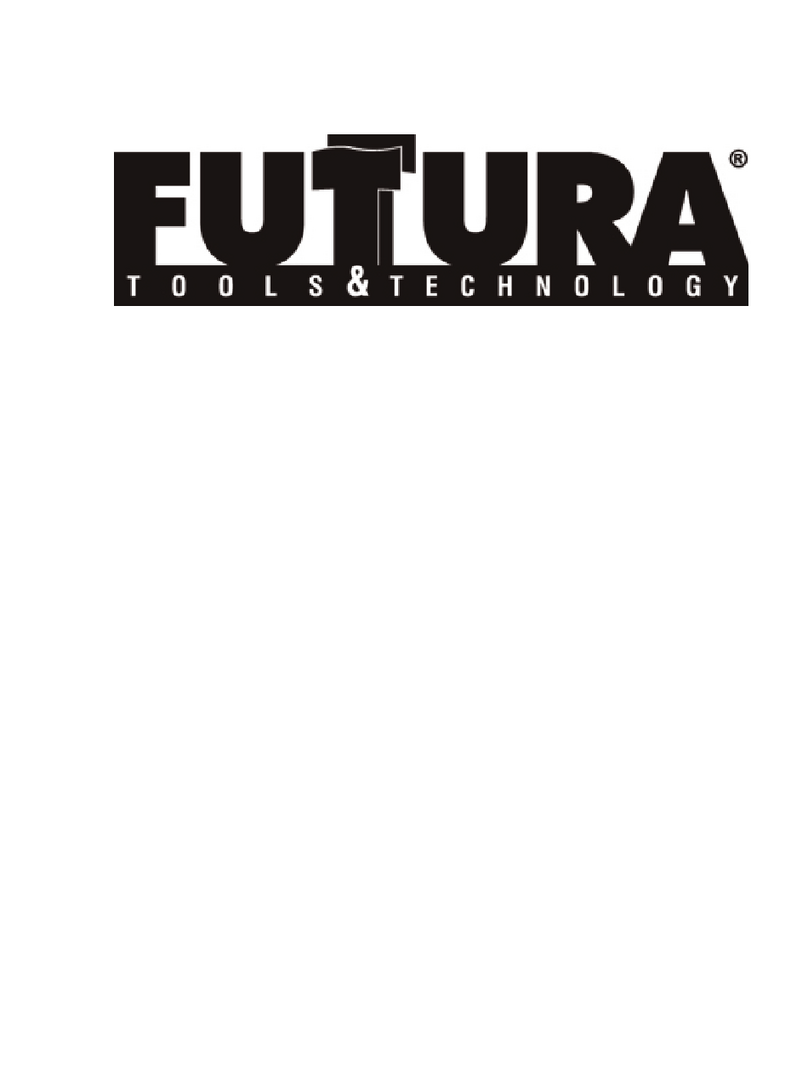
Futtura
Futtura MCB1 Installation Manual/Technical Information
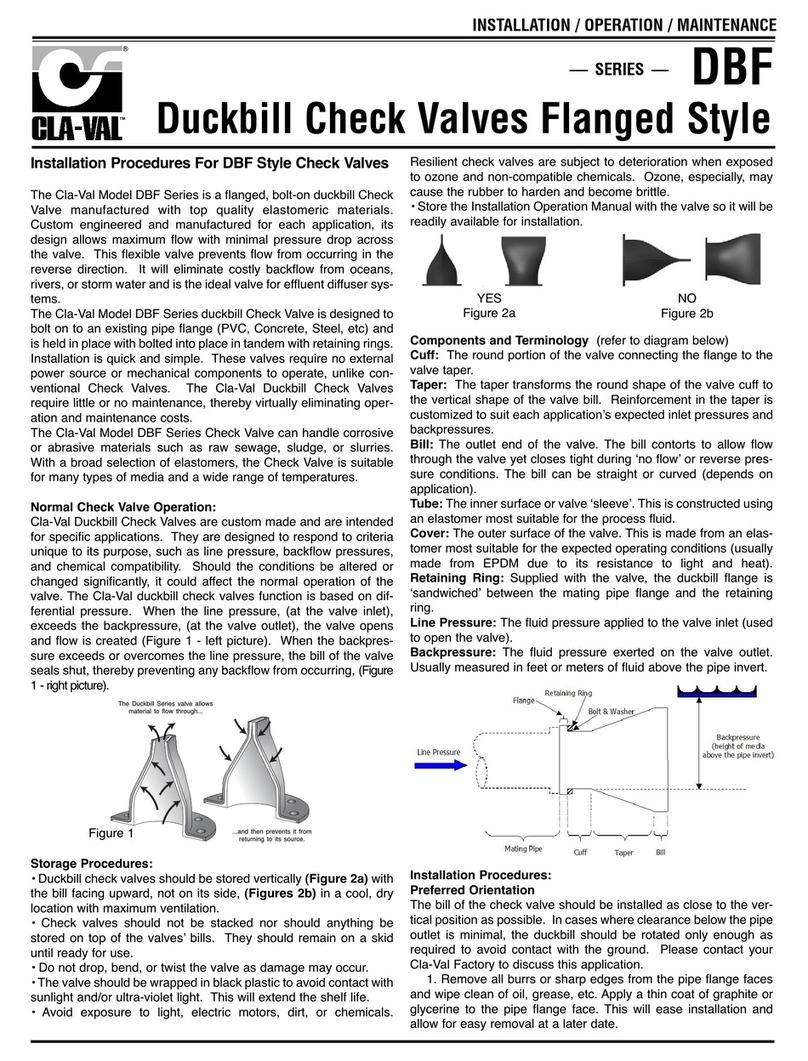
CLA-VAL
CLA-VAL DBF Series Installation operation & maintenance
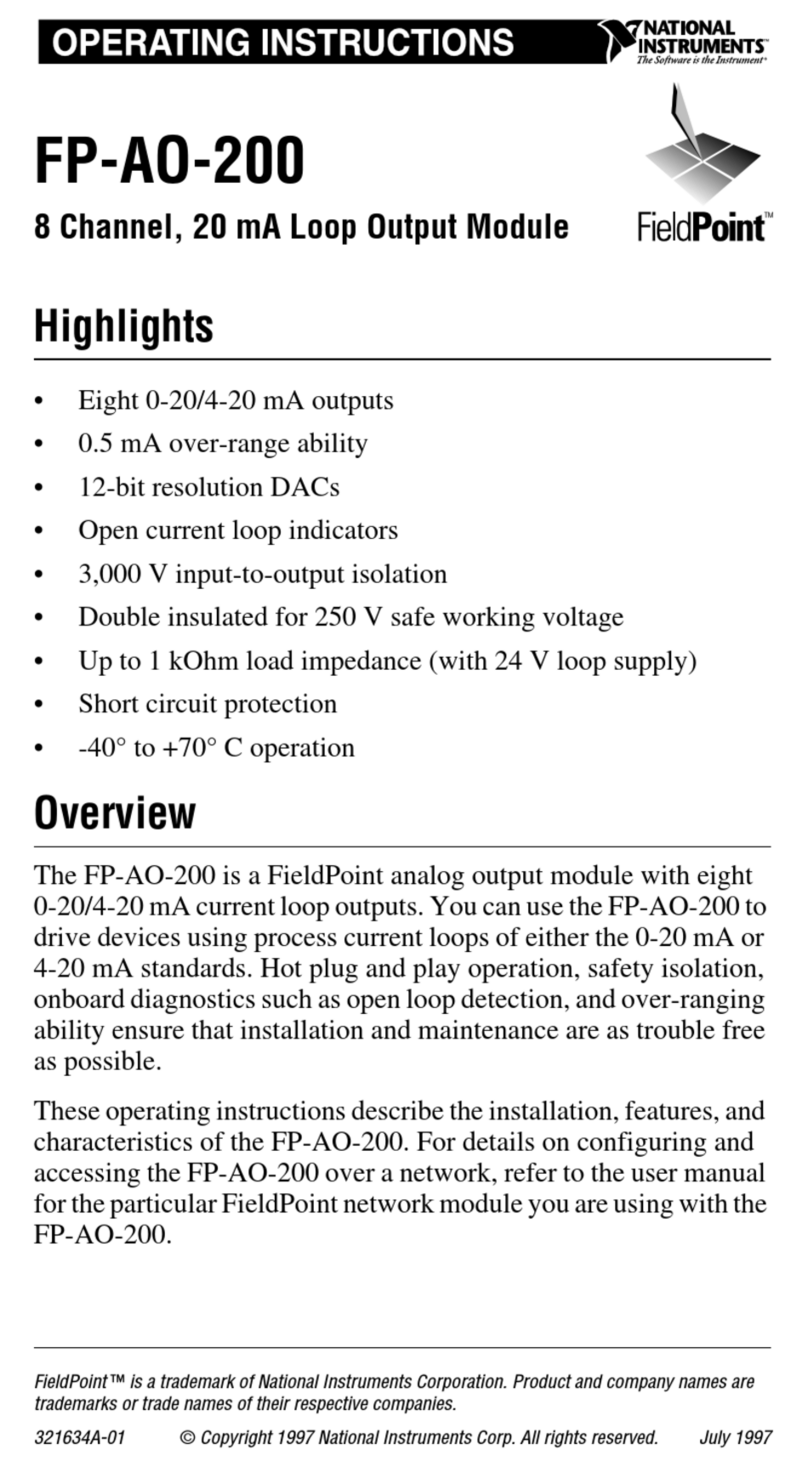
National Instruments
National Instruments FIeldPoint FP-AO-200 operating manual
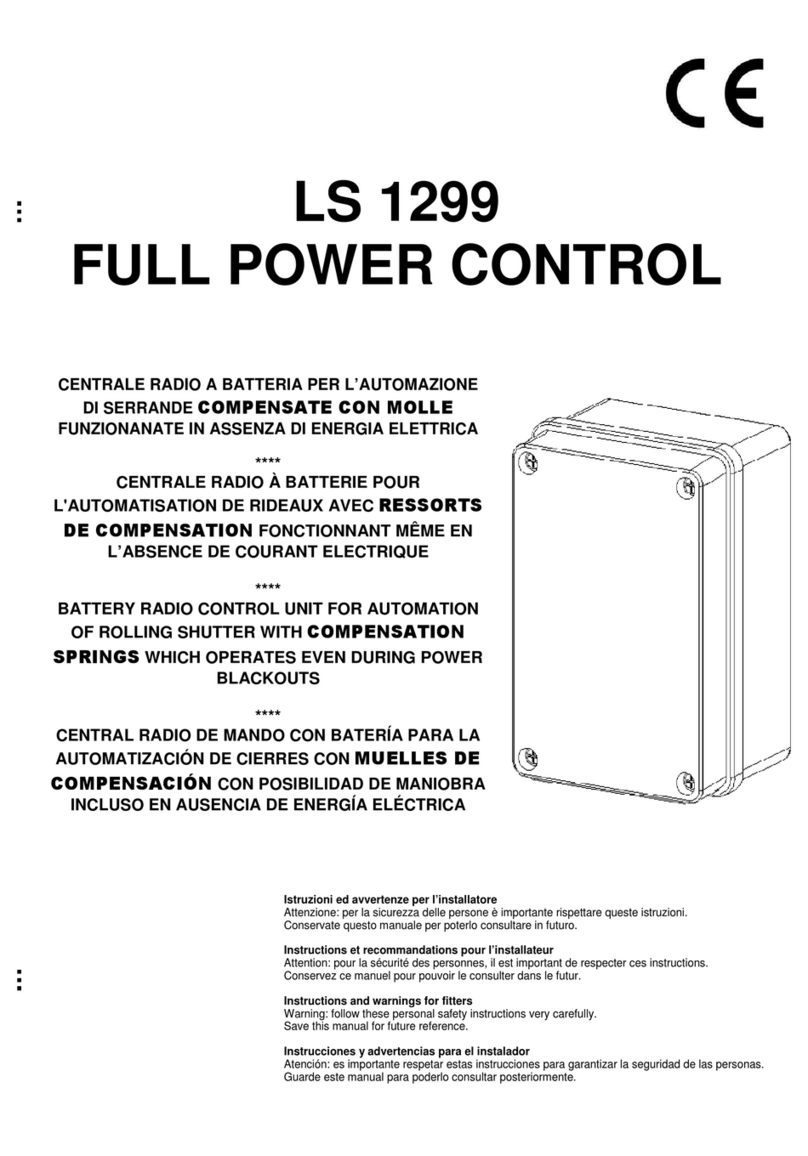
ACM
ACM LS 1299 Instructions and warnings for fitters
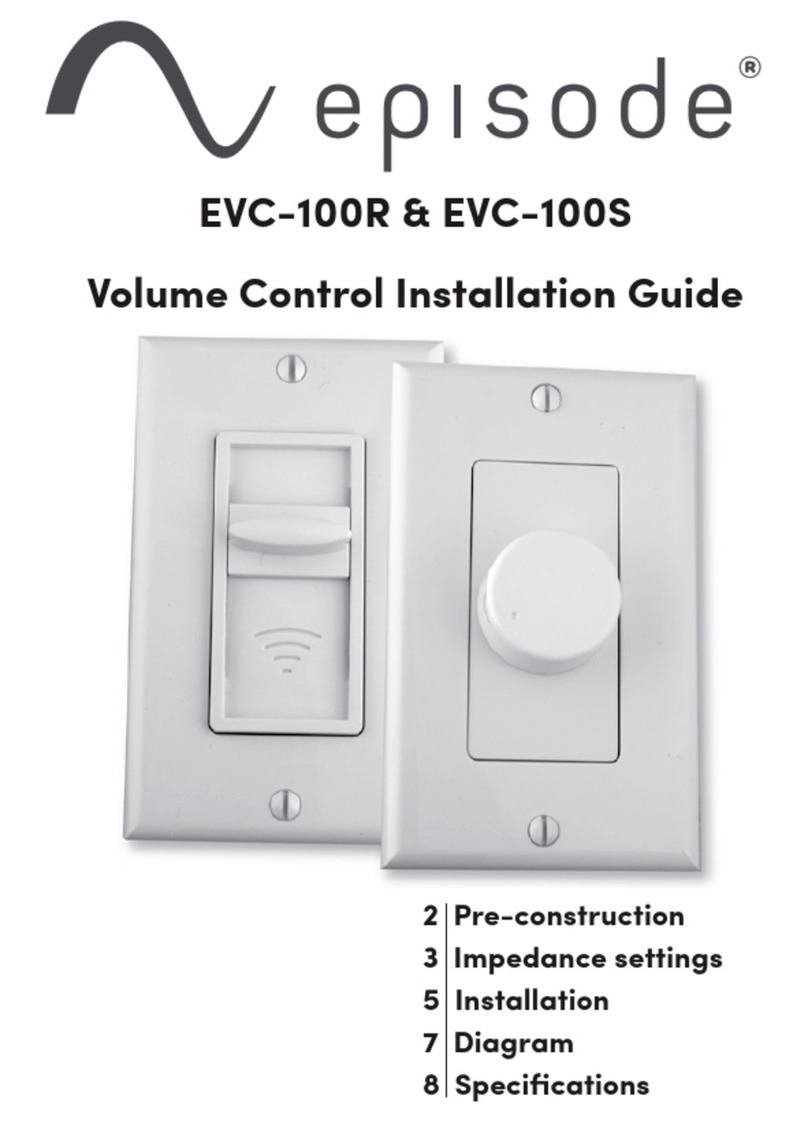
Episode
Episode EVC-100R installation guide
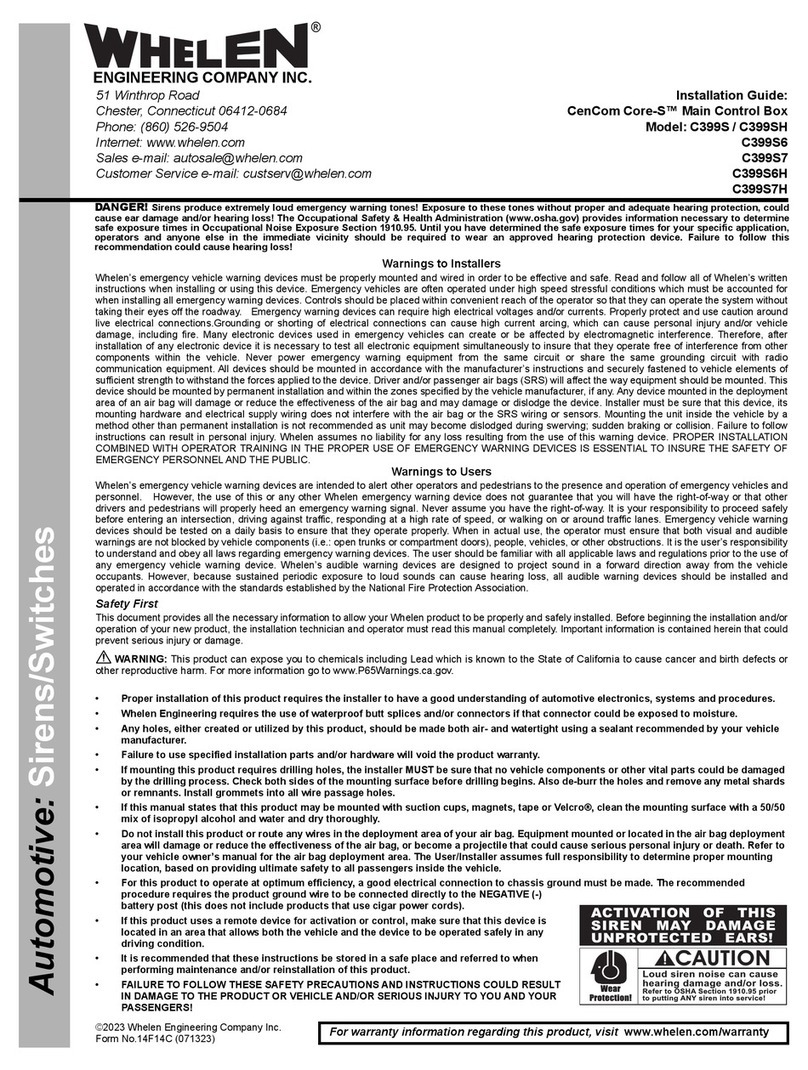
Whelen Engineering Company
Whelen Engineering Company CenCom Core-S C399S installation guide
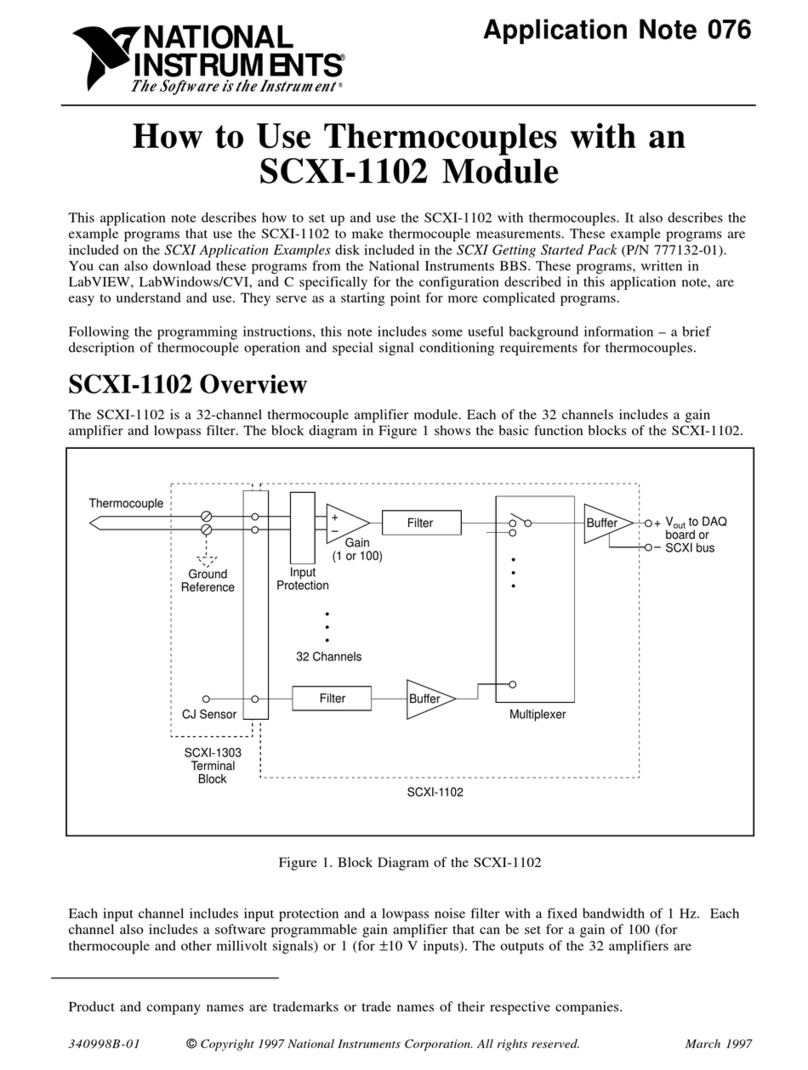
National Instruments
National Instruments SCXI SCXI-1102 Application note
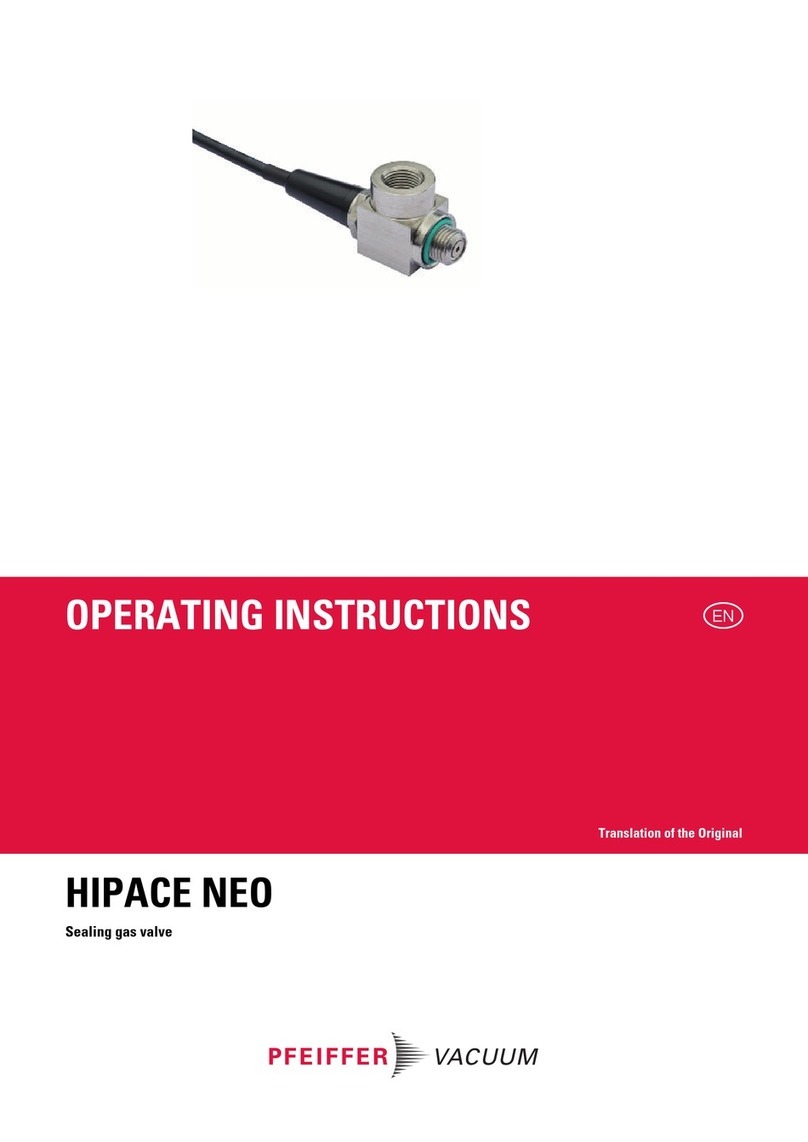
Pfeiffer Vacuum
Pfeiffer Vacuum HIPACE NEO operating instructions

Mitsubishi Electric
Mitsubishi Electric QJ71MT91 user manual
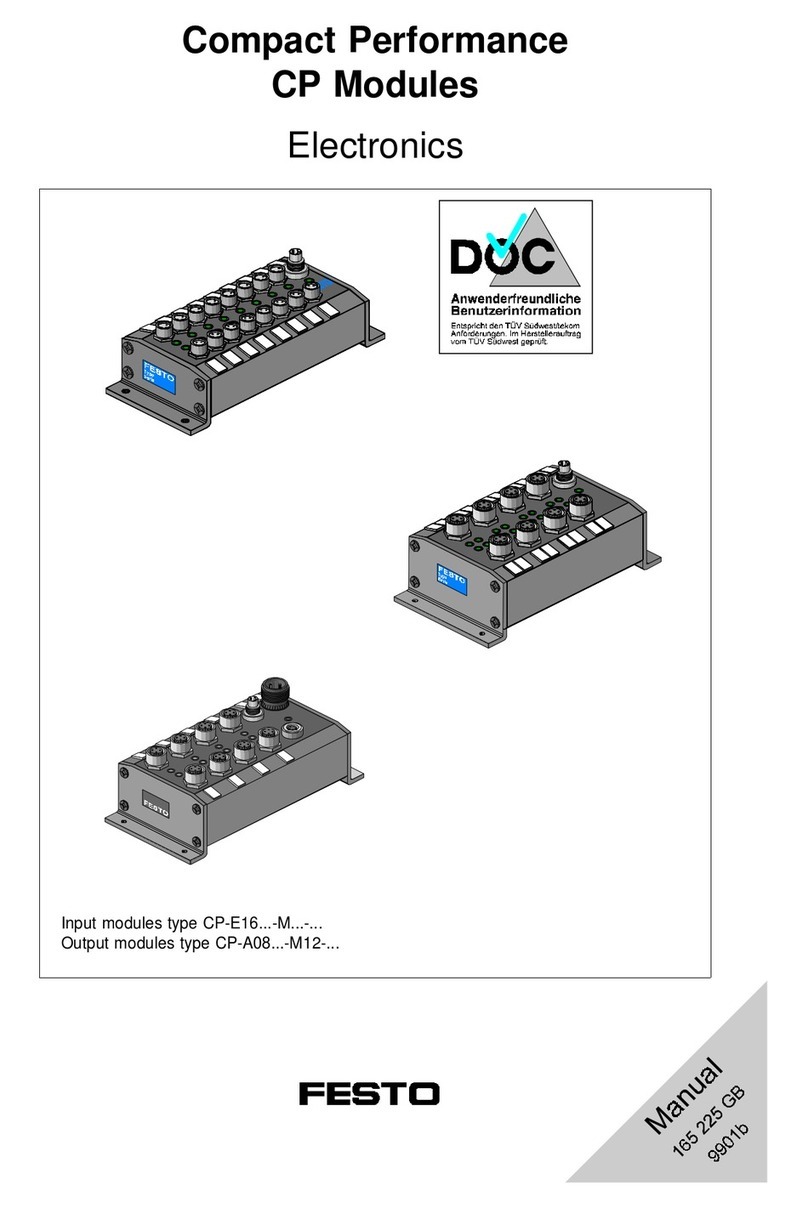
Festo
Festo CP-E16 Series manual
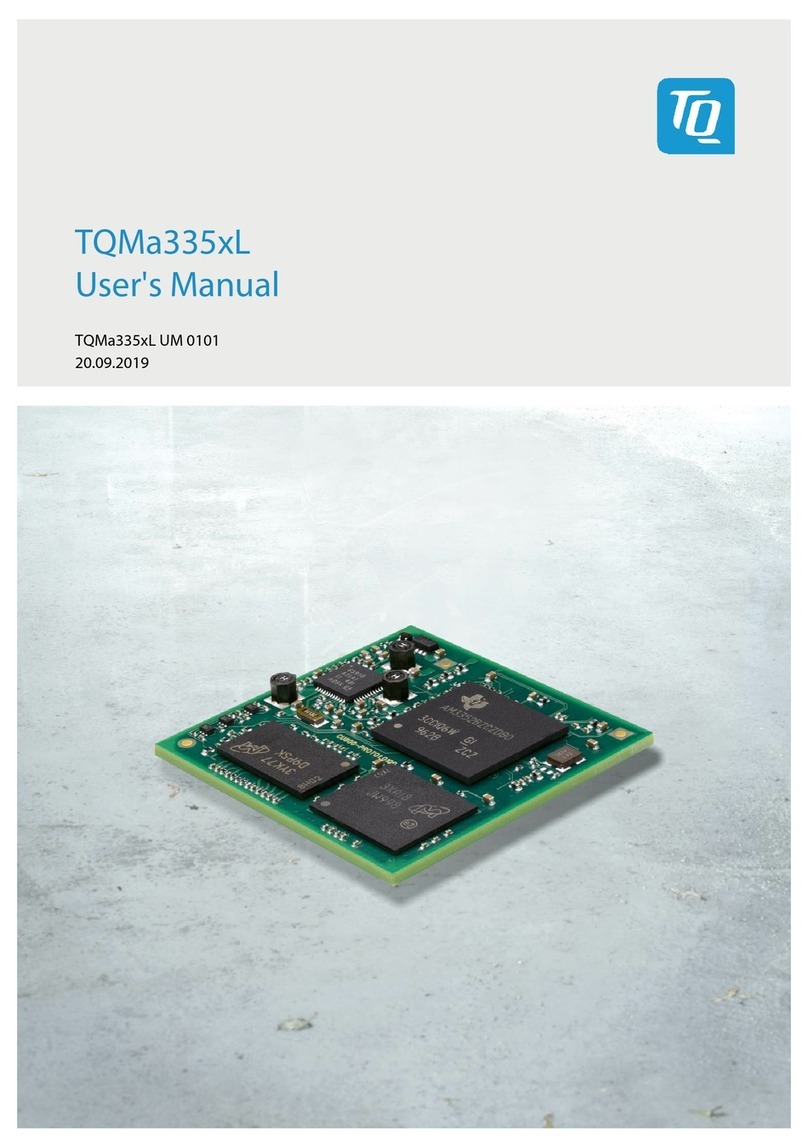
TQ
TQ TQMa335xL user manual

Mitsubishi Electric
Mitsubishi Electric A173UHCPU user manual
